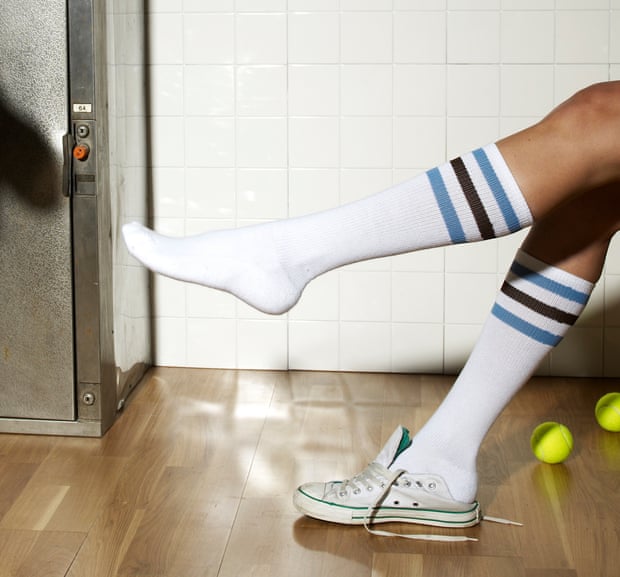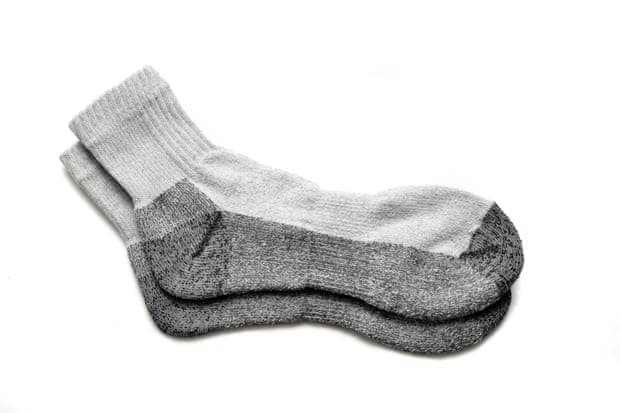How to buy socks that last: give the legs a stretch and look for reinforcement | Accessories
SSocks may be a small, sometimes invisible part of an outfit, but like a mosquito in the dark, a bad sock can be very annoying and make things extremely uncomfortable. From socks that fall off and slip under your heel, to socks that are too rough or too thin, the result is the same: blisters and difficulty walking. It’s very hard to feel composed when your socks fail on your feet.
But skipping it is a recipe for ruining your shoes. “Sweat is loaded with bacteria,” says Julia Kelly, owner of The Sockery. “To keep your sneakers smelling fresh, always wear socks… of any kind.”
In general, socks fall into three categories: athletic, business, and fashion. According to Kelly, the purpose of the sock should dictate the mix of materials and weave.
“Nowadays, socks are woven to ensure they are fit for purpose – for example, athletic, hiking or business attire – and typically involve a blend of multiple yarns,” she says. “Most manufacturers mix the yarns to create the right ‘recipe’ for the intended use.”
For Sport
Giuliano Pietrolungo, production manager at Compuknit Hosiery, says that for most people, athletic ribbed socks made from a cotton-lycra blend with terrycloth padding on the soles are a good choice.
Kelly suggests looking for moisture-wicking fibers, including wool or polyester blends like CoolMax. And avoiding 100% cotton socks “as they tend to retain moisture and are slow to dry, which is a perfect recipe for blisters.”
Depending on how seriously you take your activity, different athletic socks have different performance characteristics. According to Pietrolungo, for top-level or professional sports at a higher level, “compression socks are available that hold the foot and leg better thanks to targeted compression and more technical fibers”.
Kelly says some runners prefer toe socks because they separate the toes and prevent them from rubbing.
For everyday life
When choosing socks for everyday wear, natural fibers are generally more comfortable. With the right weave, blend and construction, they are also more durable.
According to Pietrolungo, natural fibers are best because they are breathable and insulating at the same time. He says synthetic yarns are often used to improve the sock’s durability, but if the concentration of synthetics is too high, comfort will be compromised.
Every foot is different, so the ideal mix will depend in part on personal preference. But if you have a pair of socks that make your feet particularly sweaty, it pays to pay attention to their fabric composition and go for a higher percentage of natural fibers next time.
“Wool socks offer great year-round comfort, and because wool is an insulator, they’re warm in the winter and cool in the summer,” says Kelly. “Most quality wool socks today are made from merino wool and as a result don’t itch or itch like they used to.”
Wool socks also have odor resistance. “They don’t need to be washed after every wear,” says Kelly. “They can be air-dried, which adds to a sock’s longevity and is useful when you’re on a short trip.” However, this comes at a price, as merino socks tend to be more expensive than other blends.
When choosing cotton socks, Pietrolungo says look for mercerized cotton (identified by a slight sheen) because “it feels wonderfully soft and delicate.”
Socks that stay up

“There are a few factors that help the sock stay put, but unfortunately none of them are permanent,” says Pietrolungo. “The amount of elastic at the top of the sock and down the leg contributes the most to this.”
To test this, he says, “Give the leg [of the sock] a stretch from within [to get] a good indication of how well it is holding up. But nothing can stop gravity from doing what it does over time.”
Longer socks are also more likely to have staying power, says Kelly. “In general, the sock is most likely to stay up if it fits snugly and goes over the calf.”
Durability is in the details
One way to ensure durability is through the thickness of the sock, although this needs to be balanced with comfort. “The gauge of the knitting machine, and consequently the weight of the yarn, contributes to durability,” says Pietrolungo. This can be judged by rubbing the material between your fingers and visually checking the width and density of the yarn and weave.

Another thing to look out for is extra padding. If you’re on your feet all day, you probably want a sock that has cushioning along the sole of your foot. Socks with reinforced toes and heels should also be more durable, “because those are the parts of the sock that take the most wear,” says Kelly.
There are also socks that use different fibers for different parts of the sock to maximize durability. “Humphrey Law, an Australian manufacturer, weaves a sock with wool on the inside for comfort and nylon on the outer layers to provide extra abrasion and wear resistance.”
While high-quality socks are likely to be more durable over time, how you wear and care for them also makes a difference, says Kelly. To give your socks a chance, keep your toenails trimmed, wash your feet before putting your socks on, and follow the manufacturer’s instructions when washing them.